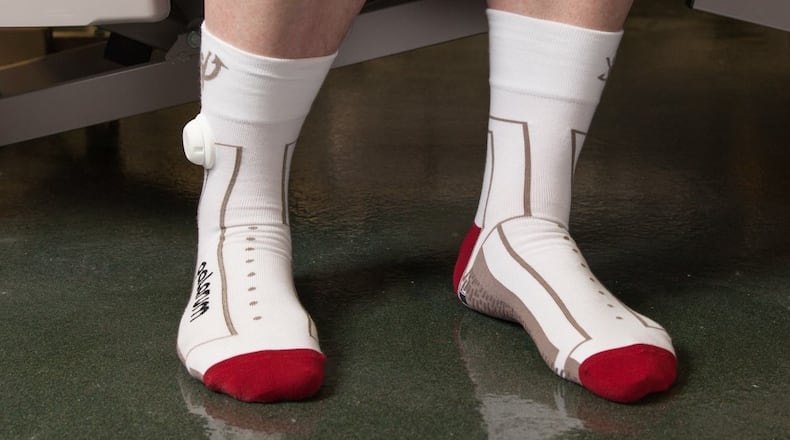Of those patient falls, 30% result in an additional injury, and 10% result in a serious injury such as a fracture or head trauma, according to federal government statistics. Baker said one-third of patients admitted to hospitals are classified as fall risks.
Data from the Centers for Medicare & Medicaid Services (CMS) indicate that the average U.S. hospital experiences nearly five falls per 1,000 patient days. In 2015, patient falls were costing healthcare facilities over $10,200 per incident.
Baker, a retired Air Force lieutenant colonel who has also served as a chief nursing officer and helped to open UC Health’s West Chester Hospital, said his company created a product called Palarum PUP (Patient is UP) SmartSocks. They are socks that are woven with a conductive yarn that can stream patient information to the nurses on that floor.
Co-founder Chris Baker, Patrick’s brother and VP of business development, said the smart socks can be worn and washed for use over and over again.
“These are socks that won’t be thrown out,” he said. “This is wearable technology that measure biometrics from your own body.”
Baker and his team were at Lebanon City Council requesting a forgivable loan of $50,000 to move out of a 3,000 square-foot office, to move to and renovate 5,000 square feet of office space on the second floor of the Sibcy Cline Building at 103 Oregonia Road.
City Council will consider the request at its meeting Tuesday. City Manager Scott Brunka said finding office space is a challenge in Lebanon.
“We felt like this is a good candidate,” he said. “We hope they will be successful and reactivate this vacant space.”
Over the past several years, Palarum has been developing its technology and undergoing clinical trials for FDA approval as a nursing tool to provide data to clinicians. Patrick Baker said their original goal was to reduce falls by 20% to 25%. He said during clinical tests, the smart socks far exceeded expectations by reducing falls 50% to 75% or about one fall per 1,000 patient nights.
Both Bakers said the technology has been peer reviewed and its clinical research was validated by an Institution Review Board at the Wexner Medical Center at The Ohio State University. The SmartSocks are being used at several Veterans Affairs hospital systems from Palo Alto, Calif. to Boston, Mass. and will begin use at the Cincinnati VA Hospital.
While hospitals have installed bed monitors for those patients who are deemed fall risks, Patrick Baker said the smart socks would be linked to the patient’s room and nursing personnel wearing a special alert badge. He said some patients may want to get up without assistance but end up falling on the floor.
If a patient gets up and falls in the room, the device would turn the room lights on and alert the three nearest employees to the patient’s room. The IoT technology can be used with other smart features in the patient room such as turning the lights on and off.
The Bakers said the SmartSocks replace the need for bed, chair and floor mat alarms in a time when remote monitoring due to the shortage of nurses is important.
The company has been at work since 2014 and is incorporated as a private LLC with the vast majority of its investors based in Cincinnati, according to the Bakers. They said the smart socks will be 100% manufactured in the U.S.
Chris Baker said their smart badge technology can be used in other applications, such as school or government building security. One Cincinnati area school is exploring that application for future use.
Palarum has also partnered with Mayfield Brain and Spine to help gather patient data to alleviate back pain and other mobility issues by gathering key measurements measuring gait speed and weight distribution to help doctors determine a treatment plan.
“While we are focused on fall prevention, this is like an EKG for mobility,” Patrick Baker said. “We’re only scratching the surface and we’re excited about the future.”
He said the company has 13 employees in four states and projects revenues of $2.1 million in 2023 and expects to grow projected revenue to more than $13 million by the end of 2026.
About the Author


